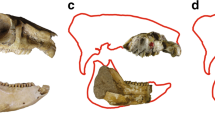Abstract
Saber-toothed carnivores, until now, have been divided into two groups: scimitar-toothed cats with shorter, coarsely serrated canines coupled with long legs for fast running, and dirk-toothed cats with more elongate, finely serrated canines coupled to short legs built for power rather than speed. In the Pleistocene of North America, as in Europe, the scimitar-cat was Homotherium; the North American dirk-tooth was Smilodon. We now describe a new sabercat from the Early Pleistocene of Florida, combining the scimitar-tooth canine with the short, massive limbs of a dirk-tooth predator. This presents a third way to construct a saber-toothed carnivore.
Similar content being viewed by others
Author information
Authors and Affiliations
Additional information
Received: 6 February 1999 / Accepted in revised from: 20 October 1999
Rights and permissions
About this article
Cite this article
Martin, L., Babiarz, J., Naples, V. et al. Three Ways To Be a Saber-Toothed Cat. Naturwissenschaften 87, 41–44 (2000). https://doi.org/10.1007/s001140050007
Issue Date:
DOI: https://doi.org/10.1007/s001140050007




